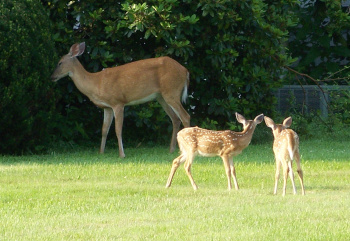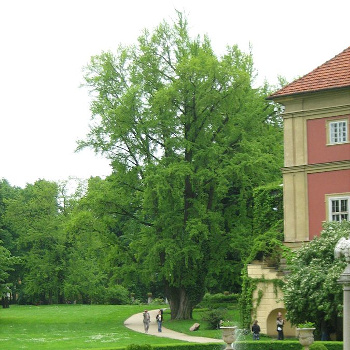
Anthropocene Extinctions
May 9, 2022 Tikalon is located in a widely forested suburban area of Northern New Jersey, and woodland animals are often sighted on our streets. These are mostly deer, but several years ago a large brown bear nearly destroyed our high-density polyethylene (HDPE) garbage can at curbside as it was looking for food. The increased sprawl of humanity across the Earth has affected animal behavior and survivability in several ways. Not only is there a loss of animal habitat, but there's also habitat fragmentation caused by roadways that prevent free animal movement. These same roadways are responsible for air, noise, and light pollution that lead to diminished animal health and increased mortality. A decade ago, a deer crossing a highway collided with my wife's car as she was driving one morning. The deer was apparently not injured, but damage to the car was extensive.
A mother deer and her fawns.
This photograph was taken early in the morning on July 16, 2021, when the animals were foraging on the lawn across from my house.
(Photo by the author. Click for larger image.)
Our present geological epoch is the Holocene, a name constructed from the Greek word ʿολος (holos, "entirely") combined with a suffix, -cene, indicating something recent; so, we live in a period that's "entirely recent." The Holocene is defined as starting 11,700 years before the year 2000, and this was the start of the Neolithic Era (New Stone Age) of human development, at which time there were globally only about five million people. Things got slightly crowded by the first century, when there were more than a hundred million people, increasing to a billion by 1800. From that point, humanity has grown more than a thousand fold to our present population of more than 7 billion, and such a large number is enough to significantly change their environment. Humanity has wrought so much change on Earth that geologists are defining a new Anthropocene geological epoch in the geologic time scale, with a name derived from the Greek word for human, ἄνθρωπος (anthropos). Since these are geologists, they are attempting to define an easily located stratigraphic marker of human presence, a "golden spike." They have appeared to settle on evidence of humans from the mid-twentieth century, the start of the Great Acceleration, a time of very rapid socioeconomic expansion and the Atomic Age. I wrote about the Anthropocene in two previous articles, The Anthropocene, January 18, 2016, and Anthropocene Minerals, August 16, 2021. Any geological marker of the Anthropocene should be easily discovered, and modern technology has produced many geological artifacts. In a span of less than an average human lifetime, humans have consumed more energy than in the twelve millennia since the start of the Neolithic. Modern-day strata contain abundant plastics, concrete and supermarket chicken bones. Other Anthropocene markers are deforestation, animal husbandry, carbon dioxide (CO2), methane (CH4), plant and animal extinction, and a spike in the diversity and distribution of mineral-like compounds.[1-3] Two botanists from the Smithsonian National Museum of Natural History, John Kress, Senior Research Botanist and Emeritus Curator of Botany, and Gary A. Krupnick of the Plant Conservation Unit, have recently published an open access paper in the journal, Plants, People, Planet that examines human impact on plant species biodiversity.[4-5] They've found that plant species are going extinct because people don't need them.[4-5] While species may tolerate slight shifts in their habitat conditions and adapt, or migrate to new habitats, those that can't may become extinct.[4] Humans have found some plant species to be useful and have therefore domesticated them, but others have been driven to extinction.[4] A related concept is co-evolution that drives unnatural selection in which creatures symbiotic with us have greatly prospered; for example, cattle, rice, and the eucalypts.[4] In their study, the Smithsonian researchers classified about 30% of vascular plant species, such as lycophytes, ferns, gymnosperms, and angiosperms, as being either winners or losers in the Anthropocene.[4] They found that losers greatly outnumber winners, and that this trend will continue in the future.[4] The researchers also mapped the winners and losers, both taxonomically and phylogenetically, across the major groups of vascular plants.[4] They classified 86,592 species into seven categories, as follow:[4]
• Winners useful to humans.
• Winners not useful to humans.
• Losers useful to humans.
• Losers not useful to humans.
• Tentative winners.
• Potential losers.
• Currently neutral species.

Plant winners and losers in the Anthropocene. (a) Ginkgo biloba, (b) Prunus serotina, (c) Magnolia ekmanii, (d) Ceratozamia kuesteriana, (e) Halophila stipulacea, (f) Merremia tuberosa, (g) Araucaria muelleri, (h) Sidalcea stipularis, (i) Cirsium canescens, (j) Asclepias oenotheroides, (k) Grusonia pulchella, (l) Cleisostoma porrigens, (m) Cytisus oromediterraneus, (n) Carex bullata, (o) Cyanea comata, and (p) Eryngium sarcophyllum. (Fig. 1 of ref. 4, licensed under a Creative Commons License (See figure caption in reference for additional details).[4] Click for larger image.)
The results show many more loser species than winners; and, if present trends continue, future losers will continue to greatly outnumber future winners.[4] Although winners and losers are distributed through nearly all the orders of vascular plants, all but two of the nine major phylogenetic lineages favor losers over winners.[4] Some of the smaller ancestral orders might be at risk of extinction.[4-5] There are 6,749 winner plants; and these, such as corn, rice, wheat, are those helpful to humans.[5] There is also the curious case of plants now extinct in the wild, such as the ginkgo tree, but survive in cities.[5] Ginkgo biloba is a popular ornamental tree also used for food, and as a dietary supplement.[5] There are 164 winners which are not useful to humans, such as the invasive kudzu.[5] Among the 20,290 loser species are the Haitian magnolia tree, cut for firewood, redwoods and junipers, and the ancient conifer, Araucariaceae.[5] 26,002 species are potential losers, 18,664 species are potential winners, and 571 plant species have already become extinct.[5] The trend is towards less biodiversity, and this will lead to a loss of animal diversity and more vulnerable ecosystems.[5] Plant communities will be much more homogenized in the future.[5] The existence of seed banks and cryogenic tissue storage means that any plant can be saved from extinction, but an effort must be made to do even such small mitigation.

Ginkgo biloba are large trees of size ranging from 20-50 meters.
Ginkgo biloba is the last living species in the order Ginkgoales, and the genus Ginkgo was found in the Middle Jurassic about 170 million years ago.
Extracts of Ginkgo biloba leaf are sold as a cognitive enhancer, but there is no evidence that it promotes enhanced memory or attention in healthy people.
(Wikimedia Commons image by Piott.)
References:
- Griffin Chure, Rachel A. Banks, Avi I. Flamholz, Nicholas S. Sarai, Mason Kamb, Ignacio Lopez-Gomez, Yinon M. Bar-On, Ron Milo, and Rob Phillips, "The Anthropocene by the Numbers: A Quantitative Snapshot of Humanity's Influence on the Planet," arXiv, January 24, 2021.
- Robert M. Hazen, Edward S. Grew, Marcus J. Origlieri, and Robert T. Downs, "On the mineralogy of the 'Anthropocene Epoch'," American Mineralogist: Journal of Earth and Planetary Materials, vol. 102, no. 3 (March, 2017), pp. 595-611.
- Catalog of 208 human-caused minerals bolsters argument to declare 'Anthropocene Epoch', Carnegie Science and the Deep Carbon Observatory Press Release, March 1, 2017.
- W. John Kress and Gary A. Krupnick, "Lords of the biosphere: Plant winners and losers in the Anthropocene," Plants, People, Planet, March 10, 2022, https://doi.org/10.1002/ppp3.10252.
- Sofia Quaglia, "Plants humans don't need are heading for extinction, study finds," The Guardian, March 10, 2022.